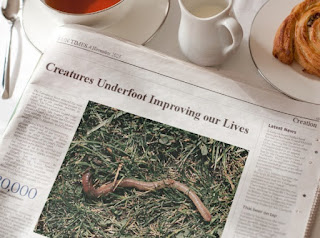Creatures Underfoot Improving our Lives
It is easy to forget something or someone when we do not see them — or know that they are affecting us in the first place. American kids sign highschool yearbooks with pledges to always be friends, but those promises were just words. Did they know the names of the janitors?
We see robins, the early birds, getting the earthworms but seldom realize that those creatures are marvels of design for their own ecosystems. In fact, earthworms and other organisms under our feet (ofttimes way under) were put here by the Creator to help our lives.
 |
| Earthworm, Pexels / Karolina Grabowska, modified at PhotoFunia |
Watch a video of how earthworms move and you'll see that they were designed for their place in this world. They have muscles, and brains that tell the muscles how to work. Interesting that there are fossils of them dated to the Cambrian, but Darwinists can evosplain that away.
People talk about "numbers of species" in the world, but soil biodiversity is not exactly understood. It could be that a huge number of life forms exist down there. For that matter, it's been said that the oceans are largely unexplored. That would also apply to learning about tiny creatures in the seawater. We have much to learn, but we do know that living things in the seas are beneficial to life as well. There are so many reasons to see that Earth was created to be inhabited (Isaiah 45:18), one would have to be a fool to deny it (Psalm 14:1, Romans 1:18-23).
Without earthworms, scientists at Colorado State calculate, we would have 25 percent less food productivity from plants. How much food service do they provide for us? About 140 million metric tons is the estimate.
. . .
For us subaerial creatures who mostly think of animals like birds, cats, and dogs, it’s a sobering thought to realize that much of our livelihood depends on hidden service animals under our feet.
. . .
Free-living organisms and microbes that live their lives on and in the ocean’s top meter of seawater are thought to play vital roles in ocean ecosystems, nutrient cycles, oxygen production, the carbon pump, and other earth processes. Yet, surprisingly, relatively little is known about these vital marine communities — collectively known as neuston — their evolution, how they develop, how they affect their environment, and how their environment affects them.
To read it all, find your way over to "Hidden Service Animals: Earthworms Are Only the Beginning."